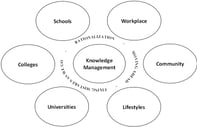Published on
Competency-Based Education: A Disruptive Force whose Time has Come

Converting a personal brand of diverse experiences into an accredited degree has been an unattainable goal for many working adults — until now. The emergence of CBE is just hitting the academic world with real-world impact and new opportunities.
This is backed by a number of public polls; 87 percent of Americans believe that students should receive college credit for knowledge and skills acquired outside of the classroom, according to a 2012 Gallup/Lumina Foundation study. That same poll revealed that 75 percent of those queried said if they could be evaluated and receive credit for what they already know, they would be more likely to enroll in college programs. This is an idea the White House and the Department of Education have openly advocated.[1]
The Background
On August 22, 2013, President Obama outlined his “Plan to Make College More Affordable” in a report released by the White House. The President stated his desire to promote innovation and competition in the higher education field through a number of different initiatives. Topping that list was this header: Award Credits Based on Learning, not Seat Time.
There has been a regulatory awakening by the Department of Education that is actively seeking new models of learning, and CBE has moved to the forefront. Prior to the President’s announcement, Secretary of Education Arne Duncan had told the New York Times, “I want them to be the norm,” referring to competency-based programs.[2] Many high-performing institutions are submitting groundbreaking competency-driven approaches.
The Problem
In 2014, there are some alarming trends in higher education. Enrollments have declined over the past year due to higher costs. A staggering 54 percent of Americans are underemployed, and employers are telling educators that the skills gap is widening. I see CBE as a way to address these issues.
More than 55 million new American jobs will be created by the end of the decade and more than 40 million of them (greater than 70 percent) will require a college-level certificate or degree, according to the Georgetown Center on Education and the Workforce.
The Solution
Provide a low-cost degree that is granted only after an individual has mastered a core set of competencies. Competencies are derived from employer requirements, professional certifications, Lumina Foundation Degree Qualifications Profile and the rubric competencies of the Association of American Colleges & Universities’ LEAP initiative. A student can complete the degree at his or her own pace. At $5,400 a year, tuition will be approximately half of what a state university would charge, and the time it would take to complete a degree would average roughly 30 months.
Embedded content eliminates the need for costly textbooks. Students will take an assessment and then adaptive software will modify the content so they will be taught only what they don’t know. This results in a mix of faculty-supported learning, algorithmic learning and analytics-produced adaptive learning. At Brandman University, we will begin offering a competency-based bachelor’s degree in business administration later this year with the goal of providing students a quicker, less expensive path to completion of their degree.
The world of higher education is opening an important door for adults seeking to take the next step in getting a promotion or a new job. With non-traditional students often juggling a family, aging parents and significant financial responsibilities, their upward mobility is often hindered by a lack of perceived knowledge in one or more critical areas despite their real-world knowledge. The shift to competency-based learning will change that.
– – – – References
[1] Paul Fain, “Beyond the Credit Hour,” Inside Higher Ed, March 19, 2013. Accessed at http://www.insidehighered.com/news/2013/03/19/feds-give-nudge-competency-based-education
[2] Tamar Lewin, “Official Calls for Urgency on College Costs,” The New York Times, November 29, 2011. Accessed at http://www.nytimes.com/2011/11/30/education/duncan-calls-for-urgency-in-lowering-college-costs.html?_r=1&
Author Perspective: Administrator



